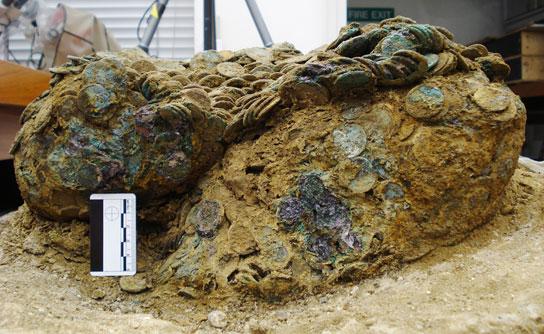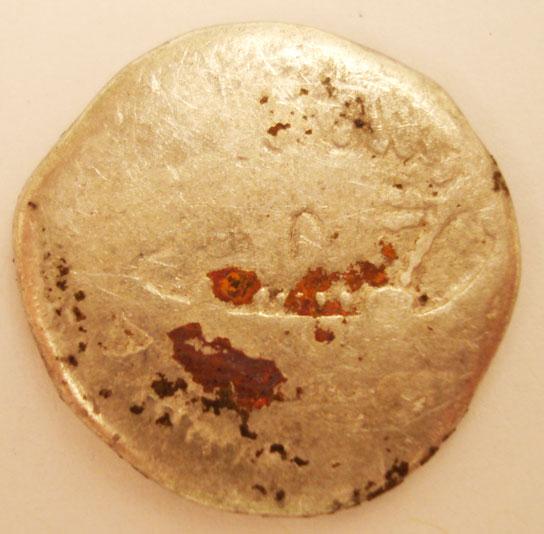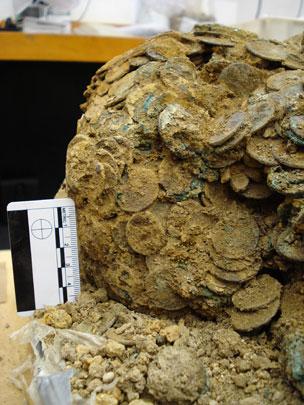Julia Tubman, conservator, British Museum
Source - http://blog.britishmuseum.org/
As mentioned in previous blog posts, the Beau Street Hoard is not just one huge jumbled mass of coins, but actually at least six separate bags. My excavation plan is to remove these coins bag by bag, to preserve the groupings (which are potentially very significant), and give us a clearer view of the size and shape of each bag.
I had been concerned that the coins might have concreted together to such an extent that identifying separate bags would be very difficult during the excavation, but (fingers crossed!) thus far the removal of individual bags has progressed remarkably smoothly. I have managed to retrieve two whole bags of coins. I have numbered these bags five and six, and they are the two smallest bags at the northern end of the block in the x-ray (five being the smallest).

The block, after the removal of bags 5 and 6
We were excited to see that bag six almost exclusively contained denarii (the smaller coins with a high silver content discussed in Eleanor’s blog post last week), suggesting that the coins might have been bagged by denomination. Of the approximately 3,000 coins I excavated of this bag, I have cleaned around 1,000, and thus far the latest coins we have date to the third century AD.
There are actually a very small number of coins older than the third century contained within the bag: one coin was minted during Otho’s very short reign (AD 69), and an even older one, worn almost flat, minted at the end of the Roman Republic by Mark Antony (just prior to the battle of Actium in 31 BC).
This means that some of the coins were centuries old at the time of the final deposition of the hoard. As I’m cleaning the coins bag by bag in the order excavated, I haven’t yet got round to cleaning the coins kept in bag five, but thus far these all appear to be radiates.

A very worn coin minted by Mark Antony, circa 31 BC
As you can see in the photographs, it is quite easy to tell where one bag ends and another begins. The orientation of the coins themselves and the very bright blue corrosion helps a lot, but there are also other markers. The bags that held the coins would have been organic in nature (made from either an animal or plant product).My guess would be leather as they would have to be strong enough to hold large numbers of coins. Unfortunately, even organic material which has been treated and processed to form objects doesn’t always survive easily in Britain, which is why most of our surviving artefacts are made from stone, ceramic or metal. With this in mind, I knew that any piece of bag that might have survived would be in very poor condition, and I was prepared to look for scant pieces of evidence preserved in the corrosion generated by the coins.

Denarius bearing the emperor Septimius Severus, AD 193-211
Happily though, I think that I have found fragments of leather (see the light brown material loosely attached to the coins), exactly where I know the bags would have been. The leather is obviously very degraded, and as the fibre network has broken up, the leather has shrunken and split resulting in the flaky incoherent material we see today. I have taken some samples of this material, and hopefully my identification of this will be confirmed by a specialist soon.

The next stage of the excavation- the removal of bag 2
After three weeks I now have a much better understanding of the size and shape of the hoard. There were no more coins beneath bags five and six, but the x-rays taken through the side suggest this is not the case throughout the rest of the block – we suspect there might be more bags of coins beneath the six already identified.
The area excavated thus far shows that the floor of the cist is obviously not even, but seems to have been dug in a rough pit-like way. As yet I have found no evidence of any kind of wooden box that might have held all of the bags, and as I have found pieces of tile pressed up against the coins, I actually doubt that there ever was.
Given the way in which the bags have been piled (I do not want to destabilise the central bags by removing their supports), and to get an idea of what the bags of coins in the middle of the block look like, I will now begin excavating ‘bag two’ at the southern end of the block. I’m sure there will be more exciting developments to report.